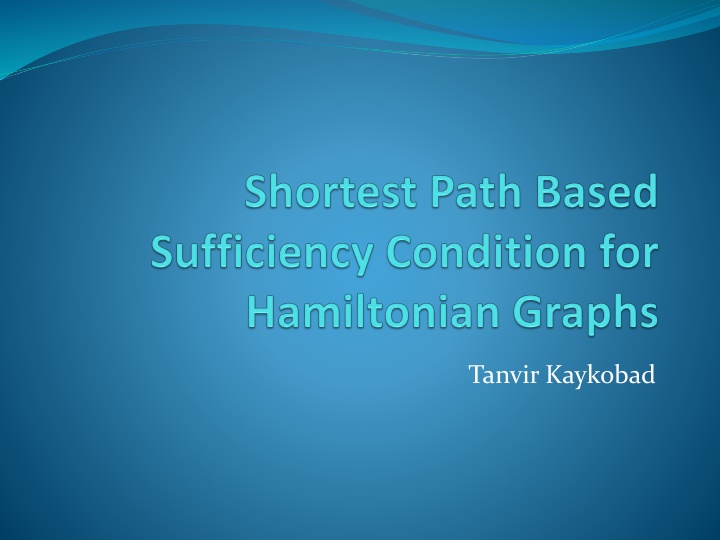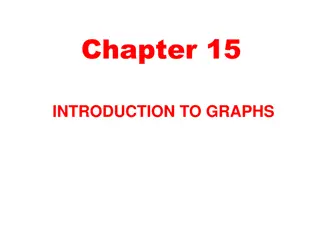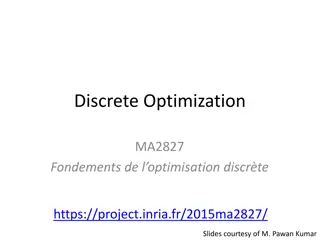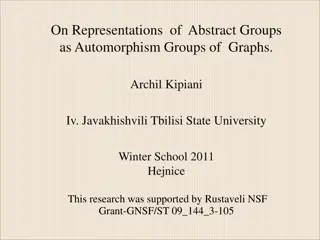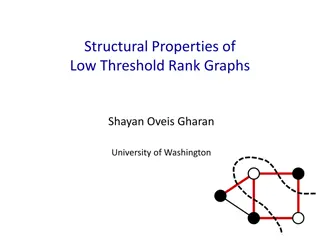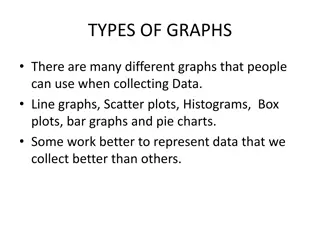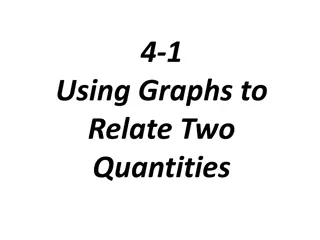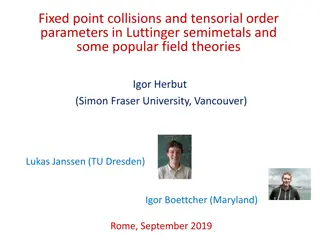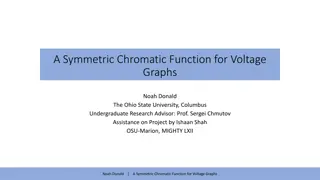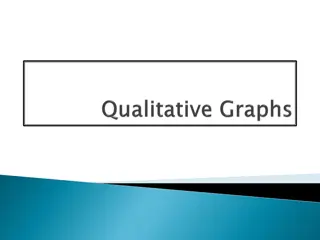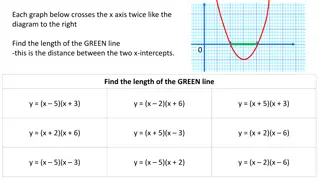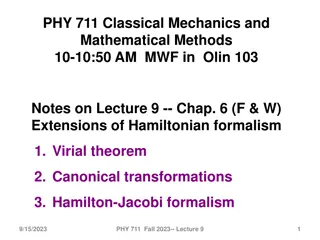Hamiltonian Graphs and Maximizing Paths
Investigate the properties of Hamiltonian graphs, sufficiency conditions for Hamiltonicity, and the concept of maximal paths. Learn about Hamiltonian cycles, crossover edges, and how to identify maximal paths that cannot be extended further. Dive into the complexities of determining whether a graph is Hamiltonian and explore the implications of different graph structures.
Download Presentation

Please find below an Image/Link to download the presentation.
The content on the website is provided AS IS for your information and personal use only. It may not be sold, licensed, or shared on other websites without obtaining consent from the author.If you encounter any issues during the download, it is possible that the publisher has removed the file from their server.
You are allowed to download the files provided on this website for personal or commercial use, subject to the condition that they are used lawfully. All files are the property of their respective owners.
The content on the website is provided AS IS for your information and personal use only. It may not be sold, licensed, or shared on other websites without obtaining consent from the author.
E N D
Presentation Transcript
Hamiltonian Graph A Hamiltonian Path is a path that traverses through each vertex of a graph exactly once A Hamiltonian Cycle is a cycle that visits every vertex of the graph exactly once A graph is Hamiltonian if it contains a Hamiltonian Cycle Finding whether a graph is Hamiltonian is an NP-complete problem.
Existing Sufficiency Conditions for Hamiltonicity Let be the degree of vertex u of a Graph or be the distance between the vertices and . Let path of length (having and be a vertices) from vertex to vertex . Dirac s Condition: In a simple graph, if for every vertex, then the graph is Hamiltonian Ore s Condition: In a simple graph, if for every nonadjacent pair Rahman and Kaykobad: If for every nonadjacent pair of vertices of a simple graph then the graph is Hamiltonian , then the graph contains a Hamiltonian path.
Our Proposition A graph is if there does not exist a set of vertices, whose removal disconnects the graph. If a graph is not Hamiltonian , it cannot be If for all non-adjacent vertices and of a simple graph , then the graph is Hamiltonian
Cross-over edge In a given path P with vertices indexed from left to right, if there is an intermediate vertex k such that k is connected to the leftmost vertex and its previous vertex (k-1) is connect to the rightmost vertex then these two edges are called edges cross-over edges. If cross-over edges exist in a path, then a cycle can be created with all the vertices in the path.
Maximal Path A maximal path is a non-extendable path that cannot be included in any cycle other than a Hamiltonian cycle. Start with a single edge path If crossover edges are found, the path forms a cycle, If there are any other vertices on the graph, we connect it to our cycle and remove one edge from the connecting vertex on the cycle to form our new path. Extend the path on any side without revisiting the same vertex If Step 3 is no longer possible and if the two ends of the path are adjacent, then it will form a cycle. We extend this cycle to a larger path. When step 2, 3 and 4 are no longer viable, we have obtained our maximal path 1. 2. 3. 4. 5.
Hamiltonicity Given a simple 2-connected graph let P be a maximal path with i and j as the end vertices. We will prove that if then the graph is hamiltonian. We will cover our proof using 4 cases
Case Since P is a maximal path, it cannot be included in any cycle other than a Hamiltonian cycle. So let us assume that there is no cross-over edges. If vertex i is connected to vertex k then vertex j cannot be connected to vertex . Now, since i is connected to vertices, Hypothesis of the theorem asserts that Hence . . That is So P must be a Hamiltonian path. Thus if end vertices of a maximal path satisfies the hypothesis of the theorem, it must be a Hamiltonian path. .
Case Case Let k be the rightmost vertex, vertex i is connected then all vertices to the left of k must also be connected to i and not to j. Similar argument will lead to all vertices to the right of k will be connected to j. Since , vertex j must also be connected to k. Now since the graph is 2-connected, vertex k cannot be a cut vertex. Therefore, there exists an edge and s to the right. This will lead to the following cycle: with q to the left of k which is Hamiltonian. This case gives us an improvement on Ore s condition
Case In this case Then and cannot be connected and there is no vertex because then the path length will be shorter and can be adjacent to at most . So , which means P is a Hamiltonian path vertices. That is
Case Since each vertex on path is adjacent to either i or j and not both, to deny crossover edges the path can be partitioned by vertex k such that all vertices up to are connected to i, and the rest are connected to j. This makes and k cut vertices Now since the graph is 2-connected, vertex k cannot be a cut vertex. Therefore, A. there exists an edge (q,s) with q to the left of k-1 and s to the right of k. Which is Hamiltonian OR B. there exist two edges (q,k-1) and (k,s). First being a bridge for vertex (k-1) and the second for k2.
Case If A: This will lead to the following cycle: If B: This will lead to the following cycle: Therefore this must be a Hamiltonian cycle
Case Let the intermediate vertices on the shortest path be where . Since vertices neighbouring to can neither be connected to i nor to j they must be vertices on the shortest path. Vertices with index must be connected to i. The vertices with index in the same way should be connected to j. Nonadjacent vertices of the shortest path cannot be connected since then the shortest path will be shorter. In order that none of the vertices must have an edge connecting vertices with index <i1 to a vertex indexed ik-2 in which case again the path length will be shorter (in fact only 3!). Thus this case cannot arise. be cut vertices we
Bibleography Dirac, G. A. (1952), "Some theorems on abstract graphs", Proceedings of the London Mathematical Society, 3rd Ser. 2: 69 81 Ore, . (1960), "Note on Hamilton circuits", American Mathematical Monthly 67 (1): 55 Mohammad Sohel Rahman and M Kaykobad and Mohammad Saifur Rahman, A New Sufficient Condition for the Existence of Hamiltonian Paths , Computers and Their Applications, pp. 56-59, ISCA, 2005
